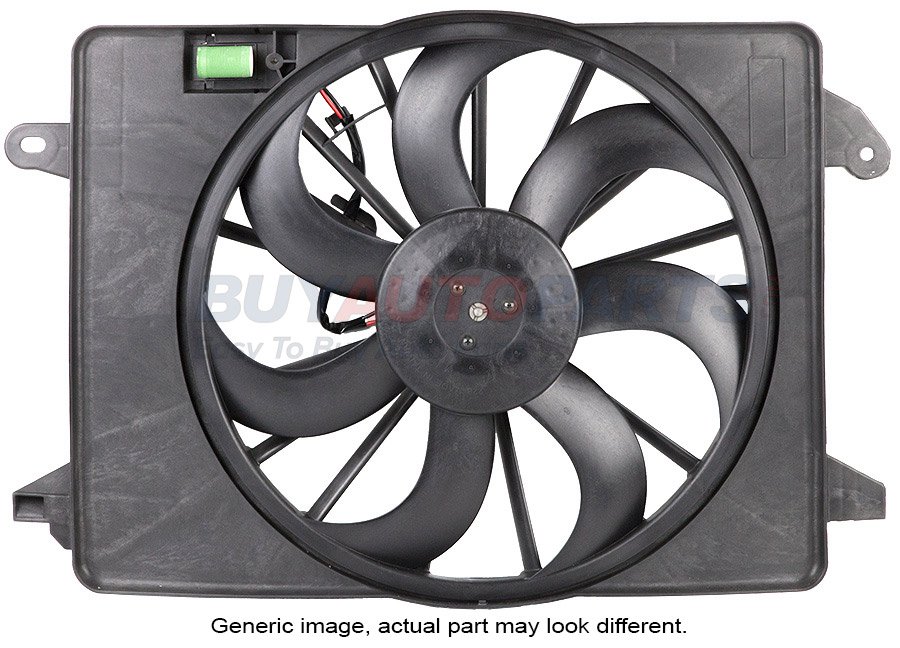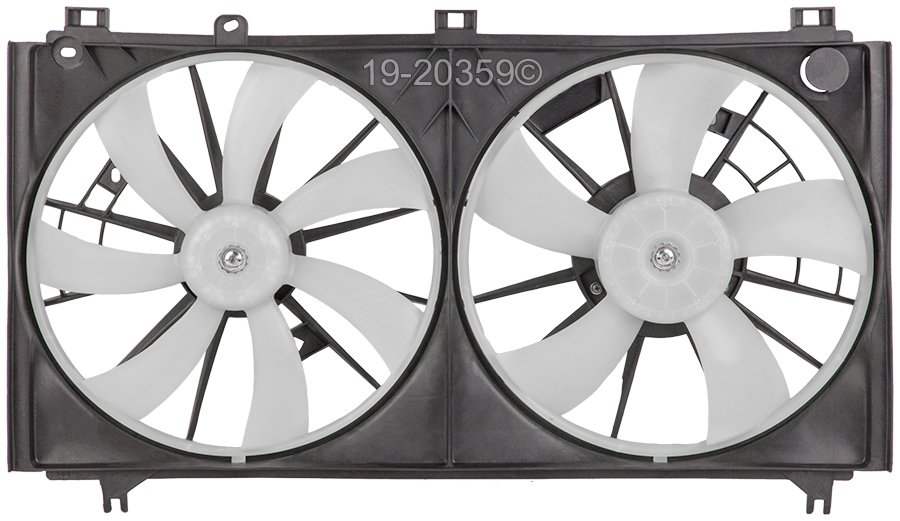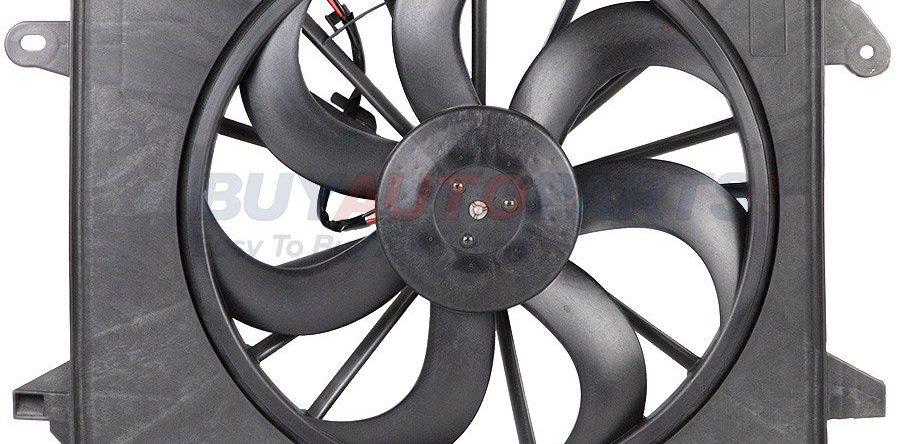How to Buy Cooling Fan Assembly

BuyAutoParts.com stocks top-quality cooling fan assemblies. Cooling fans are parts associated with radiators that keep the engine running at an ideal temperature. A malfunctioning cooling fan will cause the engine to overheat, eventually resulting in engine failure. As with other auto parts, cooling fans are frequently subjected to stress, as a result of which they exhibit signs of wearing out over time. This buyer's guide focuses on the types and the working of cooling fans. It highlights the problems that can occur in cooling fans, and the various symptoms of failure. It also elaborates on BuyAutoParts.com's SLS codes and the parts related to cooling fans.
Purpose of a Cooling Fan
The cooling fan helps in lowering the temperature of the coolant. The coolant takes the heat from the engine and flows through the radiator. As it passes through the radiator tubes, the cooling fan blows air through the radiator which removes the heat from the coolant. The coolant then flows back to the engine, starting the whole cycle again. This is the basic process by which the engine's temperature is regulated to keep it from overheating.

Types of Cooling Fans Over the years, the way cooling fans are operated has changed. Knowing the type of cooling fan used in your vehicle will help you choose the right replacement cooling fan. Engine-Driven Cooling Fans Manual cooling fans are the oldest models of engine-driven cooling fans. They are operated by a belt-pulley mechanism that is powered by the engine's crankshaft. As the engine starts operating, the manual cooling fans start working. Later, clutch mechanisms were introduced in engine-driven fans. Clutches can be classified as non-thermal and thermal clutches. In non-thermal clutch systems, the cooling fan is connected to a water pump through the clutch. The clutch is engaged or disengaged depending on the speed of the engine. Thermal clutch mechanisms include a bi-metallic spring which acts like a thermostat. The spring controls a valve which regulates the flow of the coolant from the reservoir. When the engine temperature exceeds a certain level, the valve opens and the fluid engages the clutch; when the temperature of the engine falls below a certain level, the fluid flows back to the reservoir, disengaging the clutch. Flex fans are engine-driven fans with blades that are thin and made of aluminum alloys. These fans, mainly employed in high-performance racing vehicles, stop working at higher engine speeds like the clutch-based cooling fans. These fans produce lesser vibrations and noise compared to standard fans. Electric Cooling Fans Electric fans are powered by the vehicle's electrical system and are controlled by thermal sensors. These fans are usually smaller in size compared to engine-driven fans. Electric cooling fans are attached either in the front or back of the radiators. Fans that are attached in the front, on the grille side, are called pusher fans; fans that are attached in the back, on the engine side, are called puller fans. The puller fans pull air through the radiator core while the pusher fans push air through the radiator core. Puller fans are used in automobiles where there is an ample space between the radiator and the engine. On the other hand, pusher fans are used in vehicles that have space constraints. Puller fans are widely used in vehicles and are considered more efficient than pusher fans. |
Problems with Cooling Fans
|
Symptoms of a Bad Cooling Fan
|
Precautions to be Followed while Installing a Cooling Fan
|
Why are your auto parts' OEM numbers required? Auto manufacturers tag each of their vehicle's parts with an OEM (Original Equipment Manufacturer) number. This number helps identify the right OEM part for your vehicle and find the appropriate replacement. At BuyAutoParts.com, you can find the matching part for your automobile by entering its make, model and year. Otherwise, you can locate your part by entering its OEM number. The OEM number can usually be found on the part itself. If you are unable to find the OEM number, you can call your dealership and provide them with your VIN (Vehicle Identification Number). Your dealership can use your VIN to fetch the right OEM number of your part. |
 |
BuyAutoParts.com has a seamless buying procedure. We have also installed safeguards to guide you through your buying process. If you encounter any trouble during any step of your purchase here, contact our support team right away on our toll-free number 1-888-907-7225 or drop us an e-mail at [email protected]. BuyAutoParts.com also stocks water pumps, water pump kits and water pump and cooling system gaskets at the best prices. We understand that customers wish to have all their auto-parts requirements fulfilled at one place. Hence, we have the largest selection of auto parts from gaskets to complete systems here. We also offer discounts on our parts occasionally. We wish you a pleasant shopping experience at BuyAutoParts.com! |
Frequently Asked Questions |
I am confused as to whether the problem is with my electric cooling fan or its connecting wires. |
You can follow the simple procedure below to clear your confusion: 1. Start your vehicle and wait until the cooling fan starts operating. 2. Connect one terminal of the voltmeter to the fan's electrical connection and ground the other terminal. 3. If the voltmeter reads 12 volts, the problem is with the fan. 4. Any deviation in the reading indicates a problem in the wiring. 5. If the voltmeter reads no power, the problem is with the fuses. |
How to check a radiator fan clutch? |
Before inspecting the radiator clutch, make sure that your fan is in good condition. Look for defects in the blades, water pump and belt tension. If you find any signs of wear, get them fixed or replaced at the earliest. To inspect a fan's clutch, follow the steps below: 1. Allow your engine to run and check whether the fan is running. 2. The speed of the radiator fan should be greater than that of your engine. 3. If it is not, the problem lies with the engagement of the fan clutch. |
My radiator fan employs a simple design with no clutch. How can I check it? |
Most times, a manual radiator without a clutch will stop operating due to defective fan blades or a worn-out belt. Check for loose belts and bent/broken fan blades. Check the link below for a detailed procedure to fix a cooling fan: How To Fix A Cooling Fan? |
Can I replace the radiator fan clutch on my own? |
If you are a regular DIYer who is familiar with the cooling fan assembly, you can replace it yourself. To replace the clutch, the entire cooling fan assembly needs to be removed. Ensure that you have all the required tools at hand before starting the installation process. Note: Be careful not to damage the radiator fins while replacing the clutch. |


